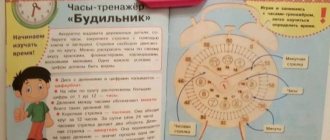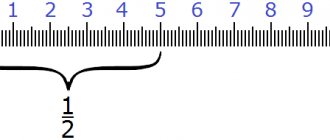Problems for parts 5th grade presentation for a lesson in mathematics (5th grade) on the topic
Slide 1
Grade 5 Problems in parts
Slide 2
Jam Day
Slide 3
A classic recipe for berry jam: For 3 parts berries, take 2 parts sugar. How many kilograms of sugar and berries do you need to buy to make 10 kg of jam? + = 3 parts 2 parts 10 kg
Slide 4
Sugar Berries 2 parts 3 parts 1) 2+3= 5 (parts) – total 2) 10:5 = 2 (kg) – makes up one part Answer: 4 kg, 6 kg 3) 2 * 2 = 4 (kg) – you need to buy sugar 4) 2 * 3 = 6 (kg) – you need to buy berries 10 kg of jam Take 2 parts sugar for 3 parts of berries. How many kilograms of sugar and berries do you need to buy to make 10 kg of jam?
Slide 5
To make cherry jam, take 2 parts berries and 3 parts sugar. How much sugar is required for 4 kg of berries? Berries Sugar 2 parts – 4 kg 3 parts – ? kg 1) 4: 2 = 2 (kg) – makes up one part 2) 2 3 = 6 (kg) – you need to take sugar Answer: 6 kg
Slide 6
Think and answer: what important condition (which is not specified, but is accepted by default) must be fulfilled in part problems? All parts discussed in the problem are equal. THINK!
Slide 7
Think and answer: what is the first thing you need to find when solving a problem into parts? You need to find out how much one part is. THINK!
Slide 8
“Unusual” carrot jam For this jam you need to take 2 parts carrots, 1 part water and 1 part sugar. How many carrots does Masha need to collect to make 8 kg of jam? Carrots Water 2 parts 1 part 8 kg jam 1 part Sugar
Slide 9
For this jam, take 2 parts cucumbers, 3 parts gooseberries and 4 parts sugar. How many cucumbers and how many gooseberries should you take if Masha has 3 kilograms of sugar? “Unusual” in a cucumber and gooseberry arena Cucumbers Gooseberries 2 parts - ? kg 3 parts - ? kg Sugar 4 parts – 3 kg
Slide 10
To make pine cone jam, add 2 parts pine cones to a syrup containing 3 parts sugar. How much sugar should you use for 400 grams of buds? “Extraordinary” in a pine cone arena
Slide 11
“Extraordinary” mushroom jam To prepare mushroom jam, you need to take 2 parts water, 2 parts mushrooms and 1 part sugar. How much jam will Masha make if the hedgehogs brought her 6 kg of russula?
Slide 12
Create your own recipe for “Unusual” jam according to the scheme 15? THINK!
Slide 13
Internet resources Recipes: https://elite-life.narod.ru/jams44.htm http://conservirovanie.ru/wps/archives/1539 http://vizhevske.ru/blog/dom-hitrosti/13121.html https:// www.vashaibolit.ru/5497-celebnye-svoystva-varenya-iz-sosnovyh-shishek.html Video: https:// vk.com/mashaimedvedtv
Tasks into parts. math trainer (5th grade)
One of the most difficult areas of mathematics is problem solving
It is difficult because in order to solve problems, the student must have logical thinking skills, the ability to establish connections in objects and actions, and understand the meaning of the text (the terms of the problem). If a student has not understood the conditions of the problem, then, naturally, he will not be able to solve it.
Solving part problems for grade 5.
Task 1. The cookbook says that for raspberry jam you need to take 3 parts of berries and two parts of sugar. How much sugar do you need for 9 kg of berries?
Solution: because 9 kg of berries make up 3 parts, then you can find out how much
kilograms account for 1 part?
9:3 = 3 kg
Sugar should be 2 parts, therefore, you need to take sugar
3 ∙ 2 = 6 kg
Task 2. Chocolates and caramels were purchased for children's New Year's gifts - 20 kg in total. How many sweets of that and other types were purchased if they bought 3 times more caramels than chocolates?
Solution: This is also a task in parts, only they need to be entered specifically. Let's assume that chocolates made up 1 part, then caramel made up 3 parts. In total, for 20 kg of sweets there are 1 + 3 = 4 (parts), therefore: 20: 4 = 5 kg then 5 ∙ 1 = 5 kg of chocolate candies 5 ∙ 3 = 15 kg of caramel
Problem 3. The lengths of the sides of a triangle are in the ratio 3:4:5. Calculate the length of each side if the perimeter of the triangle is 48 cm.
Solution: An aspect ratio of 3:4:5 means that one side is 3 parts, the second is 4 parts, and the third is 5 parts. That. We find the number of parts: 3 + 4 + 5 = 12 Next, we calculate how many cm there are in 1 part (the perimeter is the sum of the lengths of all sides) 48: 12 = 4 cm i.e. one side (3 parts) – 3 ∙ 4 = 12 cm, second side (4 parts) – 4 ∙ 4 = 16 cm, third side (5 parts) – 5 ∙ 4 = 20 cm
Objectives: Level A
- For cherry jam, take 2 parts of berries and 3 parts of sugar a) How much sugar should you take for 2600 g of berries? b) How many kg of cherries did mom have if she prepared 4 kg 500 g of sugar to make jam?
- You need to mix 3 parts sand and 2 parts cement. How much cement and sand do you need to take separately to get 30 kg of mixture?
- For the compote, we bought 1800 g of dried fruits. Apples make up 4 parts, pears 3 parts, plums 2 parts of the total weight of all fruits. How many grams of apples, pears and plums were there individually?
- Apples make up 7 parts, pears 4 parts, plums 5 parts of the total weight of dried fruits. Find the total weight of dried fruits if they contain 160 g of pear?
- When soldering tin products, an alloy containing 2 parts lead and 5 parts tin is used. a) A piece of alloy weighs 350 g. How much lead and how much tin does it contain? b) How much lead and tin does a piece of alloy contain in which there is 360 g more tin than lead?
- When grinding, for every 3 parts of flour, 1 part of waste is obtained. How much rye was ground if there was 36 quintals more flour than waste?
- We took 6 parts of apples, 5 parts of pears and 3 parts of plums. Pears and plums together 2 kg 400 g. How many dried fruits in total?
Level B
- We bought 60 notebooks, and there were twice as many squared notebooks as lined notebooks. How many parts are there in a lined notebook? on a squared notebook; for all notebooks. How many squared notebooks and how many lined notebooks did you buy?
- There were 3 times more books on the first shelf than on the second. There are 420 books on two shelves together. How many books were on each shelf?
- Dad paid 140 rubles for a shirt and tie. A shirt is 4 times more expensive than a tie. How much does a tie cost?
- A reserved seat carriage has 3 times more sleeping places than a soft carriage. There are a total of 72 seats in these carriages. How many sleeping places are there in a soft carriage?
- A boy and a girl were picking nuts in the forest. In total they picked 120 nuts. The girl picked 2 times less than the boy. How many nuts did the girl pick? How old is the boy?
- The girl read 3 times fewer pages than she had left to read. The book has a total of 176 pages. How many pages did the girl read?
- You need to put 56 nuts into two bags so that one contains 3 times more than the other. How many nuts should I put in each bag?
- The tear-off calendar has 366 sheets. By September, there were 2 times fewer sheets left in the calendar than were torn off. How many sheets were torn off?
- The student bought 3 times more squared notebooks than lined notebooks. Moreover, there were 18 more of them than lined notebooks. How many notebooks did the student buy?
- There were 4 times more books on the first shelf than on the second. This is 12 more books than on the second shelf. How many books were on each shelf?
- In three days, Mitya read 84 pages. On the first day he read 3 times more than on the second, and on the third – 16 pages. How many pages did Mitya read on the first day?
- A piece of fabric 76 m long was cut into 3 parts. The first of them is 25 m long, and the second is 2 times shorter than the third. Find the length of the second and third parts.
- The daughter is 4 times younger than her mother and 9 times younger than her grandmother. How old are they each if they are 98 years old together?
- Seryozha has 3 times fewer stamps in his collection than Vasya, and Andrey has 2 times more than Vasya. How many marks does each person have if Andrei has 80 marks more than Seryozha?
- There are 36 pieces of chalk in two boxes. When 12 pieces of chalk were used up from one box, there was 3 times less chalk in it than in the other. How many pieces of chalk were in each box originally?
- There are 5 liters of milk in two cans. When 1 liter was added to one jar, it contained 2 times more milk than the other. How many liters of milk were in each can initially?
- Three large bags and four small bags contain 550 g of cookies. How many grams are in a small bag if it contains 2 times less cookies than a large one?
- The six small boxes contain 12 more pencils than the two large ones. How many pencils are in all the small boxes and how many are in all the big ones, if one small box contains 2 times fewer pencils than a large one?
Presentation: “Tasks “in parts”
mathematics in 5th grade lesson No. 32 10/17/17
Topic: “Problems into parts”
Lesson objectives:
Introduce a new type of word problems - part problems.
Deepen and strengthen the acquired knowledge and skills in solving problems into parts, develop an algorithm for solving such problems.
To develop cognitive activity, creativity, ingenuity and intelligence in students.
Formation of methods of mental and research activity.
Developing students' educational skills.
regulatory UUD:
- use an algorithm to solve cognitive problems
- carry out final and step-by-step control based on the results
- carry out comparison and classification according to specified criteria
cognitive UUD:
- collect and highlight information essential to solving a problem , under the guidance of a teacher
- searching for the necessary information to complete educational tasks using educational literature
- carry out comparison and classification according to specified criteria.
communicative UUD:
- agree on joint activities, come to a common decision, including in situations of conflict of interests.
- express your point of view at the initiative of the teacher;
During the classes
I. Organizational moment
II. Teacher's opening speech
- Guys, today in class we will continue to learn how to solve problems.
– Problem solving is an art that can be learned. As the American mathematician George Polya said, “If you want to swim, go into the water, and if you want to learn how to solve problems, then solve them.”
– Solving problems requires a lot of work; it fosters will, perseverance, curiosity, and ingenuity. After all, even the proverb says: “A mind without a guess is not worth a penny.”
III.
Setting the lesson goal.
– Today in class we will learn how to solve problems into parts.
– Open your notebooks, write down the date and topic of the lesson.
IV. Learning new material.
– Guys, you have three tasks in front of you (everyone of you has such tasks on your desk). Read them.
– What word is repeated all the time in these problems? (parts).
– Think about what quantities are found in these problems?
– Here are several quantities: time, temperature, speed, weight, part, distance, mass, area, quantity, perimeter. Select the ones that appear in these problems. (part,
mass, quantity).
– Now we will solve these problems.
VI.
Primary consolidation.
Task 1. To make raspberry jam, you need to take 3 parts of berries and 2 parts of sugar. How much sugar should you use for 9 kg of berries?
Let's analyze the problem.
– What is included in raspberry jam? (berries,
sugar)
- What is said about berries? (3
parts)
- What is said about sugar? (2
parts)
– What is asked in the problem?
- Look at the cups. What are they? (they are all the same)
– The most important thing in such problems
is to find the mass of one part! (if they don’t answer, give me a hint).
– How many kg of sugar are in 1 part? (9:3=3kg
– mass of one part)
– If we know the mass of one part, then...
– How many kg of sugar should I take? (3∙2=6kg
– you need to take sugar)
Answer: 6 kg.
Task 2. For cement mortar, you need to mix 3 parts sand and 2 parts cement. How much cement and sand separately do you need to take to get 30 kg of mortar?
– What is included in the composition of cement mortar? (sand,
cement)
- What is said about sand? (3
parts)
- What is said about cement? (2
parts)
- Do we know the mass of sand and cement? (No)
– What is 30 kg? Mass of solution.
- So, the question of the task? How much cement and sand separately do you need to take to get 30 kg of mortar?
– Let’s make a drawing in a notebook, one part is 1 cm.
- Let's draw up a solution plan.
– 30 kg – how many parts are there? (5)
– So, the first point is 1) How many parts are there in the entire solution.
– If 30 kg is 5 parts, then what can we find out? 2) What is the mass of one part.
– If we find out the mass of one part, can we answer the question of the problem? ( Yes)
– Let’s solve the problem at the board using questions
VII. Physical education minute
VIII. Consolidation of the studied material.
Task 3. To prepare rice porridge, you need to take 2 parts rice, 3 parts milk and 5 parts water. How much milk and how much water will be needed if you take 220 g of rice?
– What is included in rice porridge? (rice, milk, water)
- Let's draw up a solution plan.
– Solve the problem yourself and then check.
– Let’s create an algorithm for solving problems into parts:
– What is common in solving these problems? Where does solving problems into parts begin?
1) Calculation of one part
- Calculation of those parts that are asked about in the problem.
Algorithm for solving problems into parts
1) Calculation of one part
- Calculation of those parts that are asked about in the problem.
IX.
Educational independent work.
– Now, using the algorithm, solve the problem yourself with an explanation, drawing up a diagram. The tasks are given according to options - separately for young housewives and separately for young masters.
- Let's check the solutions to the problems.
(if you have time, you can solve an additional problem)
– Let’s solve an additional problem:
Walnut cake
Sugar – 10 parts, Walnuts – 6 parts; Flour – 7 parts;
Butter – 4 parts; Cream – 2 parts.
How many grams of each product do you need to take to get a cake weighing 600 grams?
– What component do we know the mass of? (walnuts)
– 180 grams is 6 parts.
– Make a solution plan and solve the problem.
X. Lesson summary.
– What type of word problems did you learn about in class today?
– What quantities are used in part problems?
– Does the diagram help solve problems?
– Formulate an algorithm for solving problems into parts.
– Grades for the lesson...
XI.
Reflection.
How do you feel when you leave math class today?
XII. Homework.
– Textbook:
section 4.3, No. 489, 490 (a) Additionally: solve one problem on the card.




